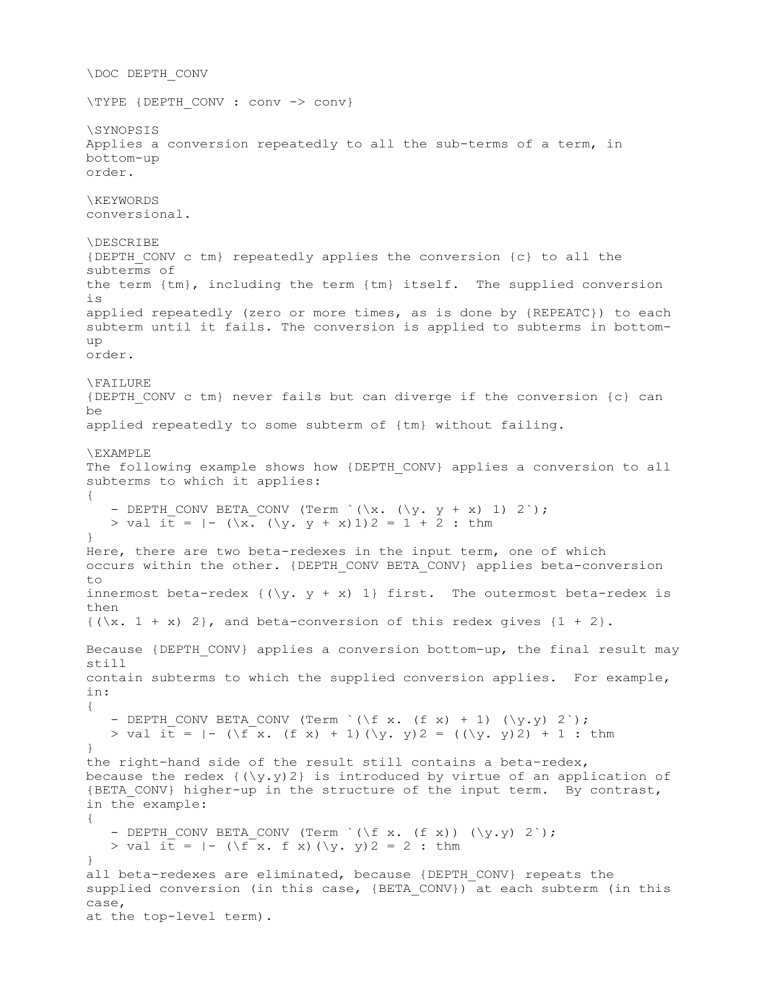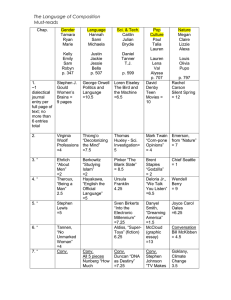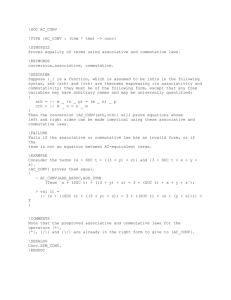\DOC DEPTH_CONV \TYPE {DEPTH_CONV : conv -> conv} \SYNOPSIS

\DOC DEPTH_CONV
\TYPE {DEPTH_CONV : conv -> conv}
\SYNOPSIS
Applies a conversion repeatedly to all the sub-terms of a term, in bottom-up order.
\KEYWORDS conversional.
\DESCRIBE
{DEPTH_CONV c tm} repeatedly applies the conversion {c} to all the subterms of the term {tm}, including the term {tm} itself. The supplied conversion is applied repeatedly (zero or more times, as is done by {REPEATC}) to each subterm until it fails. The conversion is applied to subterms in bottomup order.
\FAILURE
{DEPTH_CONV c tm} never fails but can diverge if the conversion {c} can be applied repeatedly to some subterm of {tm} without failing.
\EXAMPLE
The following example shows how {DEPTH_CONV} applies a conversion to all subterms to which it applies:
{
- DEPTH_CONV BETA_CONV (Term `(\x. (\y. y + x) 1) 2`);
> val it = |- (\x. (\y. y + x)1)2 = 1 + 2 : thm
}
Here, there are two beta-redexes in the input term, one of which occurs within the other. {DEPTH_CONV BETA_CONV} applies beta-conversion to innermost beta-redex {(\y. y + x) 1} first. The outermost beta-redex is then
{(\x. 1 + x) 2}, and beta-conversion of this redex gives {1 + 2}.
Because {DEPTH_CONV} applies a conversion bottom-up, the final result may still contain subterms to which the supplied conversion applies. For example, in:
{
- DEPTH_CONV BETA_CONV (Term `(\f x. (f x) + 1) (\y.y) 2`);
> val it = |- (\f x. (f x) + 1)(\y. y)2 = ((\y. y)2) + 1 : thm
} the right-hand side of the result still contains a beta-redex, because the redex {(\y.y)2} is introduced by virtue of an application of
{BETA_CONV} higher-up in the structure of the input term. By contrast, in the example:
{
- DEPTH_CONV BETA_CONV (Term `(\f x. (f x)) (\y.y) 2`);
> val it = |- (\f x. f x)(\y. y)2 = 2 : thm
} all beta-redexes are eliminated, because {DEPTH_CONV} repeats the supplied conversion (in this case, {BETA_CONV}) at each subterm (in this case, at the top-level term).
\USES
If the conversion {c} implements the evaluation of a function in logic, then
{DEPTH_CONV c} will do bottom-up evaluation of nested applications of it.
For example, the conversion {ADD_CONV} implements addition of natural number constants within the logic. Thus, the effect of:
{
- DEPTH_CONV reduceLib.ADD_CONV (Term `(1 + 2) + (3 + 4 + 5)`);
> val it = |- (1 + 2) + (3 + (4 + 5)) = 15 : thm
} is to compute the sum represented by the input term.
\COMMENTS
The implementation of this function uses failure to avoid rebuilding unchanged subterms. That is to say, during execution the exception
{QConv.UNCHANGED} may be generated and later trapped. The behaviour of the function is dependent on this use of failure. So, if the conversion given as an argument happens to generate the same exception, the operation of {DEPTH_CONV} will be unpredictable.
\SEEALSO
Conv.ONCE_DEPTH_CONV, Conv.REDEPTH_CONV, Conv.TOP_DEPTH_CONV.
\ENDDOC


